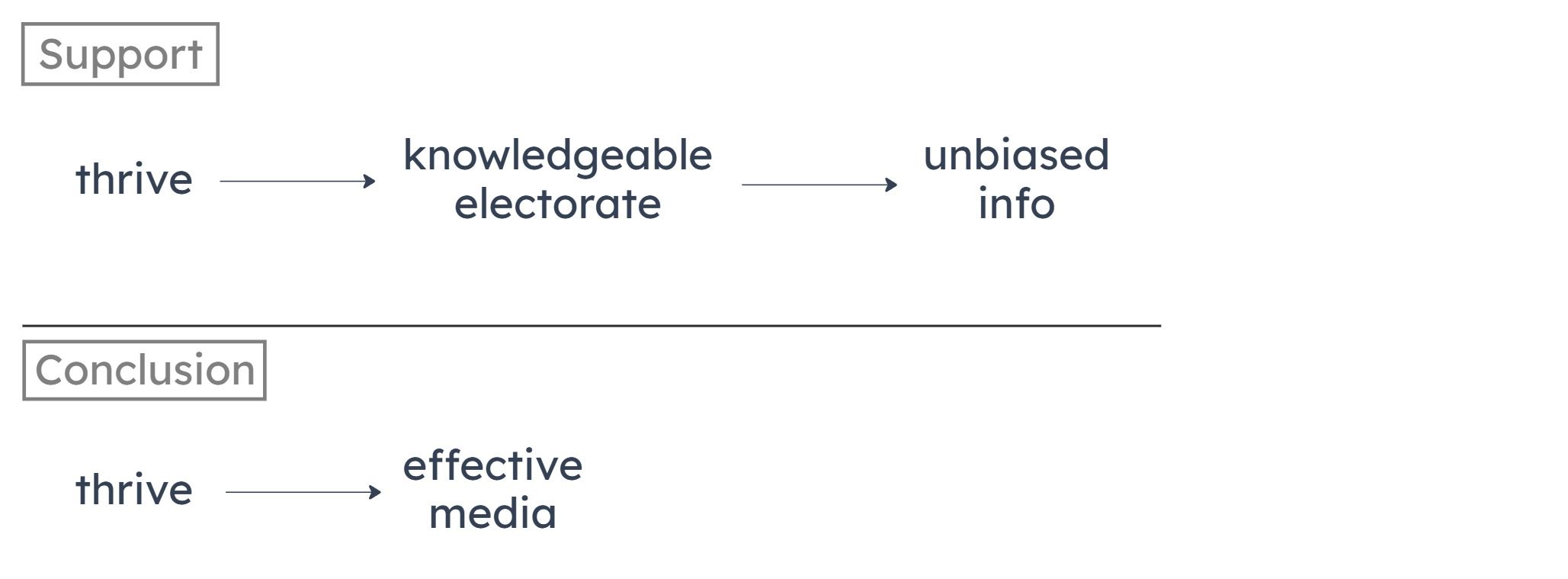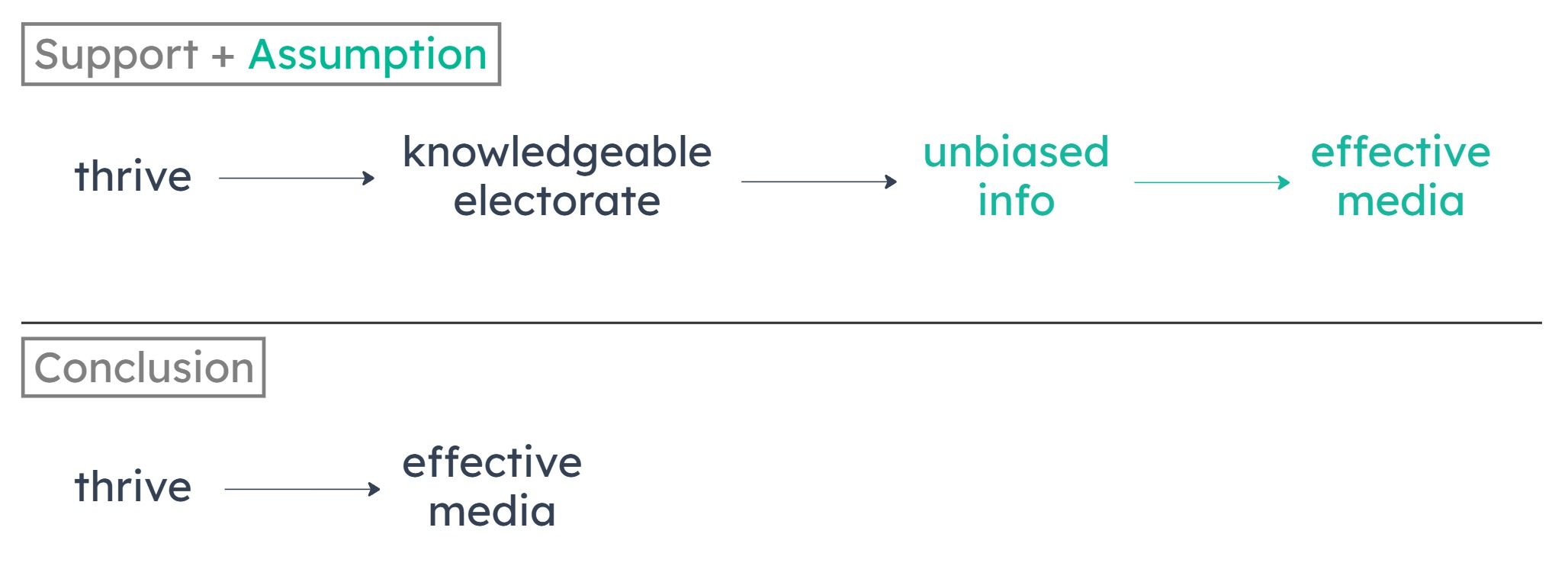In order for a democracy to thrive, it must have an electorate that is knowledgeable about important political issues. And in order for an electorate to be knowledgeable about important political issues, it must have access to unbiased info about the government.

A
All societies that have effective news media are thriving democracies.
B
If an electorate has access to unbiased information about the government, then that electorate will be knowledgeable about important political issues.
C
A democracy will thrive if its electorate is knowledgeable about important political issues.
D
A democracy cannot thrive if the electorate is exposed to biased information about the government.
E
Without effective news media, an electorate will not have access to unbiased information about the government.

(1) If Roberta is irritable, then she is tired.
(2) If Roberta loses things, then she is tired.
(3) Roberta is yawning and she lost her keys.

The argument establishes that Roberta is tired, but the author treats “tired” as sufficient for “irritable.” According to premise 1, “tired” is necessary. In other words, Roberta could be losing things and therefore be tired but still not be irritable.
A
infers from a correlation between tiredness and yawning that tiredness causes yawning
B
assumes the conclusion that it sets out to prove
C
generalizes on the basis of a single instance
D
takes a necessary condition for Roberta’s losing things to be a sufficient condition
E
takes a necessary condition for Roberta’s being irritable to be a sufficient condition
There is an excellent question raised about how an "and" got translated into an "or". I did not explain that in the video so I'm going to clarify here.
The original statement is: The only songs Amanda has ever written are blues songs and punk rock songs.
Following the naive translation mechanisms that we learned, we identify "the only" as Group 1 (sufficient) and the two ideas as [songs Amanda has ever written] and [blues songs and punk rock songs]. We translate as A -> B and P
But that's wrong. The conjunction in the necessary condition is incorrect. It should actually be "B or P".
To correctly understand the original statement, we have to appeal to our intuitions. We first identify the domain as the set of all past songs that Amanda has ever written. That's the set of songs we're talking about. Not the set of songs that Amanda might or will write in the future. Not the set of songs that Beihai or Chibi Maruko wrote. No. We're looking at the set of songs that Amanda has already written in the past.
Now look into that set. Pick up a random member (i.e. song). What is true of that song? Think about this.
Is it true that the song is simultaneously a blues song and a punk rock song? Well, no. That can't be true. Because that would contradict the meaning of "blues song" and "punk rock song". A blues song is precisely not a punk rock song (just like how it's precisely not a rap song or a reggae song). And vice versa. What we're actually saying about any particular song under that domain is that it must be either a blues song or a punk rock song. B or P. A -> B or P
That's must be the right interpretation. But how did the "and" in the original statement turn out to express an "or" in the logical relationship?
The answer is that it didn't. The word "and" isn't what laid down the or relationship. Rather, the or relationship was laid down when the sentence forced the categories of blues and punk rock together under one domain.
I think this is something we can see more clearly in the following examples because we're more familiar with animal categorizations than we are with musical categorizations.
All the pets the Gupta family has ever owned have been fish and parrots.
Every pet the Gupta family has ever owned have been fish and parrots.
The Gupta family has never owned any pets other than fish and parrots.
All three sentences express the same idea. All three sentences also happen to use "and". And all three sentences are expressing "fish or parrot". Here we're talking about a different domain. The domain is the set of all pets the Gupta family has ever owned. Look into that set. Pick up one member (i.e. pet). What is true about that member? Is it the case that it is both a fish and a parrot? No, because what the fuck is a fish-parrot? What is true is that the pet was either a fish or a parrot. The or relationship between fish and parrot existed as soon as you forced the two categories under the same domain. pet -> fish or parrot
A
Any neurotransmitter that leaks from a damaged or oxygen-starved nerve cell will damage surrounding nerve cells.
B
Stroke patients exhibit a wide variety of abnormal chemical levels in their blood.
C
Glutamate is the only neurotransmitter that leaks from oxygen-starved or physically damaged nerve cells.
D
Leakage from damaged or oxygen-starved nerve cells is the only possible source of glutamate in the blood.
E
Nerve cells can suffer enough damage to leak glutamate without being destroyed themselves.
There is an excellent question raised about how an "and" got translated into an "or". I did not explain that in the video so I'm going to clarify here.
The original statement is: The only songs Amanda has ever written are blues songs and punk rock songs.
Following the naive translation mechanisms that we learned, we identify "the only" as Group 1 (sufficient) and the two ideas as [songs Amanda has ever written] and [blues songs and punk rock songs]. We translate as A -> B and P
But that's wrong. The conjunction in the necessary condition is incorrect. It should actually be "B or P".
To correctly understand the original statement, we have to appeal to our intuitions. We first identify the domain as the set of all past songs that Amanda has ever written. That's the set of songs we're talking about. Not the set of songs that Amanda might or will write in the future. Not the set of songs that Beihai or Chibi Maruko wrote. No. We're looking at the set of songs that Amanda has already written in the past.
Now look into that set. Pick up a random member (i.e. song). What is true of that song? Think about this.
Is it true that the song is simultaneously a blues song and a punk rock song? Well, no. That can't be true. Because that would contradict the meaning of "blues song" and "punk rock song". A blues song is precisely not a punk rock song (just like how it's precisely not a rap song or a reggae song). And vice versa. What we're actually saying about any particular song under that domain is that it must be either a blues song or a punk rock song. B or P. A -> B or P
That's must be the right interpretation. But how did the "and" in the original statement turn out to express an "or" in the logical relationship?
The answer is that it didn't. The word "and" isn't what laid down the or relationship. Rather, the or relationship was laid down when the sentence forced the categories of blues and punk rock together under one domain.
I think this is something we can see more clearly in the following examples because we're more familiar with animal categorizations than we are with musical categorizations.
All the pets the Gupta family has ever owned have been fish and parrots.
Every pet the Gupta family has ever owned have been fish and parrots.
The Gupta family has never owned any pets other than fish and parrots.
All three sentences express the same idea. All three sentences also happen to use "and". And all three sentences are expressing "fish or parrot". Here we're talking about a different domain. The domain is the set of all pets the Gupta family has ever owned. Look into that set. Pick up one member (i.e. pet). What is true about that member? Is it the case that it is both a fish and a parrot? No, because what the fuck is a fish-parrot? What is true is that the pet was either a fish or a parrot. The or relationship between fish and parrot existed as soon as you forced the two categories under the same domain. pet -> fish or parrot